George Konidaris
MIT
Meta-Learning Transferable Parameterized Skills
Jun 07, 2022
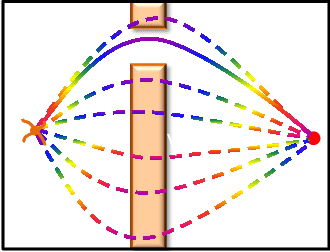

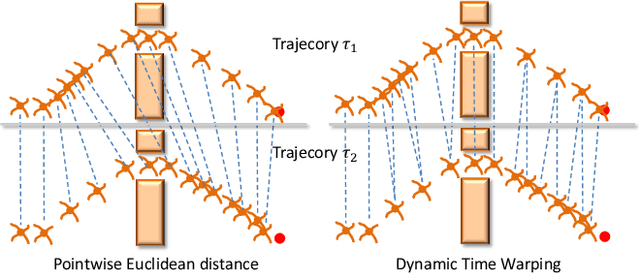
Abstract:We propose a novel parameterized skill-learning algorithm that aims to learn transferable parameterized skills and synthesize them into a new action space that supports efficient learning in long-horizon tasks. We first propose novel learning objectives -- trajectory-centric diversity and smoothness -- that allow an agent to meta-learn reusable parameterized skills. Our agent can use these learned skills to construct a temporally-extended parameterized-action Markov decision process, for which we propose a hierarchical actor-critic algorithm that aims to efficiently learn a high-level control policy with the learned skills. We empirically demonstrate that the proposed algorithms enable an agent to solve a complicated long-horizon obstacle-course environment.
Characterizing the Action-Generalization Gap in Deep Q-Learning
May 11, 2022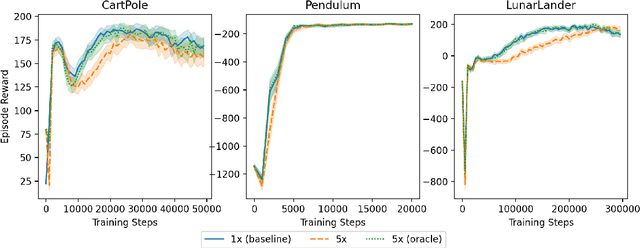


Abstract:We study the action generalization ability of deep Q-learning in discrete action spaces. Generalization is crucial for efficient reinforcement learning (RL) because it allows agents to use knowledge learned from past experiences on new tasks. But while function approximation provides deep RL agents with a natural way to generalize over state inputs, the same generalization mechanism does not apply to discrete action outputs. And yet, surprisingly, our experiments indicate that Deep Q-Networks (DQN), which use exactly this type of function approximator, are still able to achieve modest action generalization. Our main contribution is twofold: first, we propose a method of evaluating action generalization using expert knowledge of action similarity, and empirically confirm that action generalization leads to faster learning; second, we characterize the action-generalization gap (the difference in learning performance between DQN and the expert) in different domains. We find that DQN can indeed generalize over actions in several simple domains, but that its ability to do so decreases as the action space grows larger.
Learning Abstract and Transferable Representations for Planning
May 04, 2022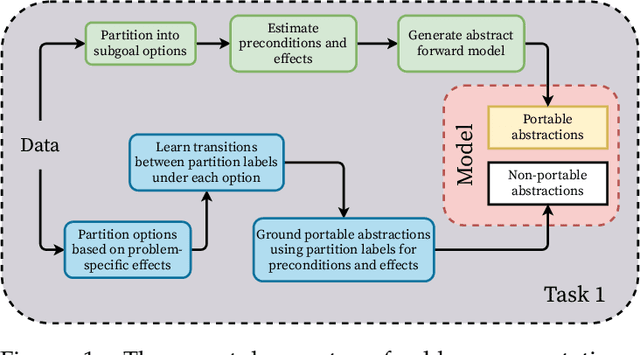
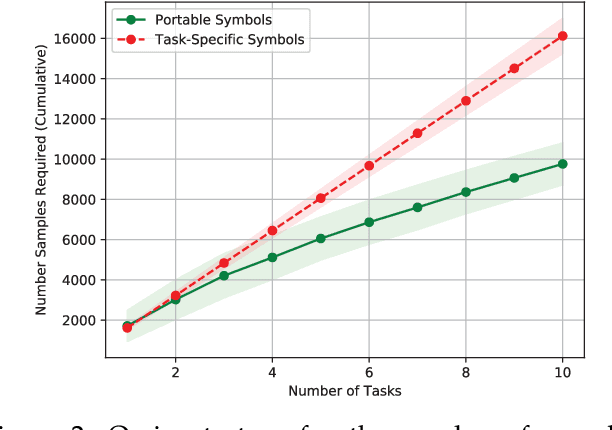
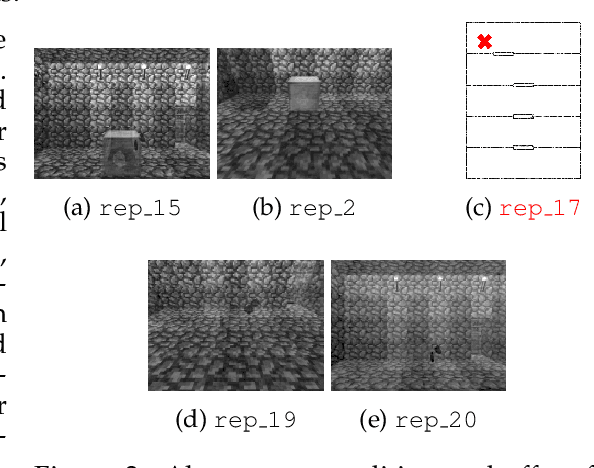
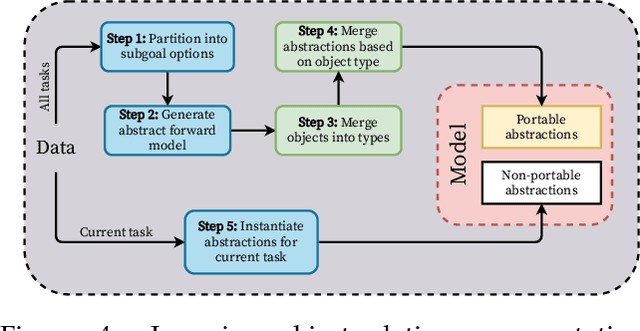
Abstract:We are concerned with the question of how an agent can acquire its own representations from sensory data. We restrict our focus to learning representations for long-term planning, a class of problems that state-of-the-art learning methods are unable to solve. We propose a framework for autonomously learning state abstractions of an agent's environment, given a set of skills. Importantly, these abstractions are task-independent, and so can be reused to solve new tasks. We demonstrate how an agent can use an existing set of options to acquire representations from ego- and object-centric observations. These abstractions can immediately be reused by the same agent in new environments. We show how to combine these portable representations with problem-specific ones to generate a sound description of a specific task that can be used for abstract planning. Finally, we show how to autonomously construct a multi-level hierarchy consisting of increasingly abstract representations. Since these hierarchies are transferable, higher-order concepts can be reused in new tasks, relieving the agent from relearning them and improving sample efficiency. Our results demonstrate that our approach allows an agent to transfer previous knowledge to new tasks, improving sample efficiency as the number of tasks increases.
Adaptive Online Value Function Approximation with Wavelets
Apr 22, 2022
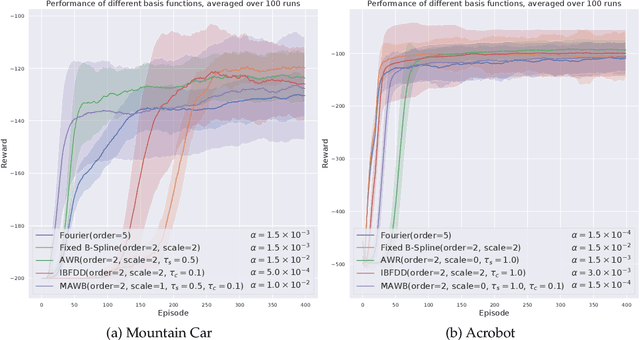

Abstract:Using function approximation to represent a value function is necessary for continuous and high-dimensional state spaces. Linear function approximation has desirable theoretical guarantees and often requires less compute and samples than neural networks, but most approaches suffer from an exponential growth in the number of functions as the dimensionality of the state space increases. In this work, we introduce the wavelet basis for reinforcement learning. Wavelets can effectively be used as a fixed basis and additionally provide the ability to adaptively refine the basis set as learning progresses, making it feasible to start with a minimal basis set. This adaptive method can either increase the granularity of the approximation at a point in state space, or add in interactions between different dimensions as necessary. We prove that wavelets are both necessary and sufficient if we wish to construct a function approximator that can be adaptively refined without loss of precision. We further demonstrate that a fixed wavelet basis set performs comparably against the high-performing Fourier basis on Mountain Car and Acrobot, and that the adaptive methods provide a convenient approach to addressing an oversized initial basis set, while demonstrating performance comparable to, or greater than, the fixed wavelet basis.
Automatic Encoding and Repair of Reactive High-Level Tasks with Learned Abstract Representations
Apr 18, 2022
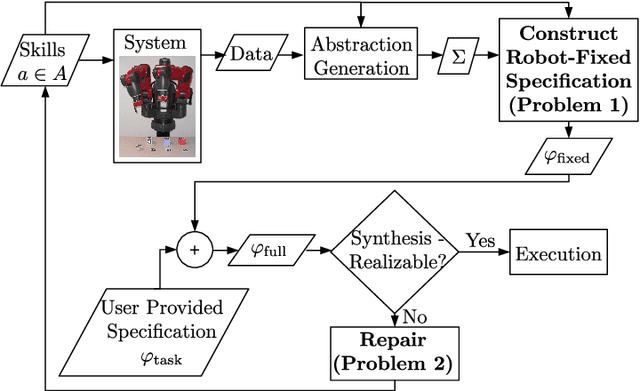

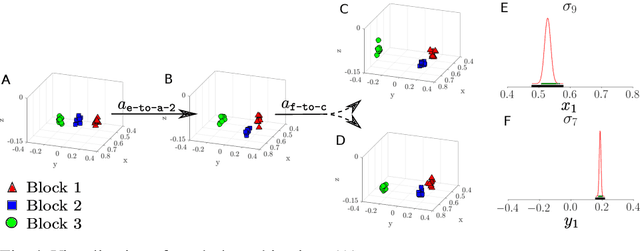
Abstract:We present a framework that, given a set of skills a robot can perform, abstracts sensor data into symbols that we use to automatically encode the robot's capabilities in Linear Temporal Logic. We specify reactive high-level tasks based on these capabilities, for which a strategy is automatically synthesized and executed on the robot, if the task is feasible. If a task is not feasible given the robot's capabilities, we present two methods, one enumeration-based and one synthesis-based, for automatically suggesting additional skills for the robot or modifications to existing skills that would make the task feasible. We demonstrate our framework on a Baxter robot manipulating blocks on a table, a Baxter robot manipulating plates on a table, and a Kinova arm manipulating vials, with multiple sensor modalities, including raw images.
Hierarchical Reinforcement Learning of Locomotion Policies in Response to Approaching Objects: A Preliminary Study
Mar 20, 2022
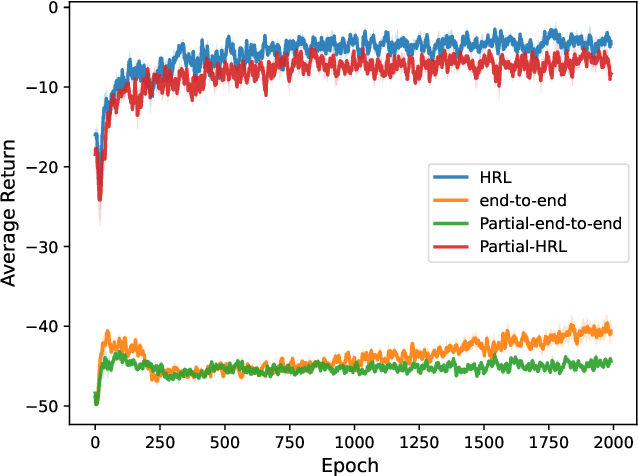
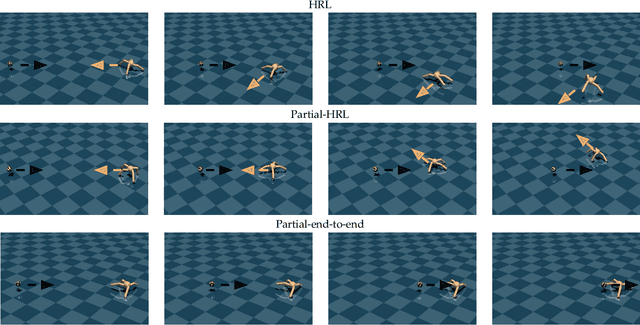
Abstract:Animals such as rabbits and birds can instantly generate locomotion behavior in reaction to a dynamic, approaching object, such as a person or a rock, despite having possibly never seen the object before and having limited perception of the object's properties. Recently, deep reinforcement learning has enabled complex kinematic systems such as humanoid robots to successfully move from point A to point B. Inspired by the observation of the innate reactive behavior of animals in nature, we hope to extend this progress in robot locomotion to settings where external, dynamic objects are involved whose properties are partially observable to the robot. As a first step toward this goal, we build a simulation environment in MuJoCo where a legged robot must avoid getting hit by a ball moving toward it. We explore whether prior locomotion experiences that animals typically possess benefit the learning of a reactive control policy under a proposed hierarchical reinforcement learning framework. Preliminary results support the claim that the learning becomes more efficient using this hierarchical reinforcement learning method, even when partial observability (radius-based object visibility) is taken into account.
IKFlow: Generating Diverse Inverse Kinematics Solutions
Nov 17, 2021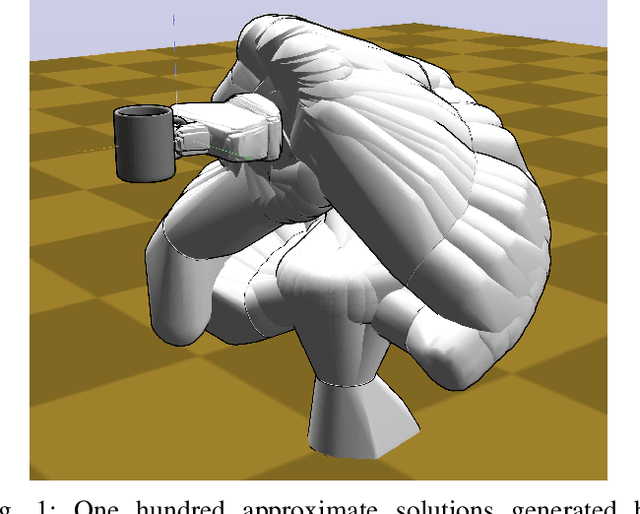


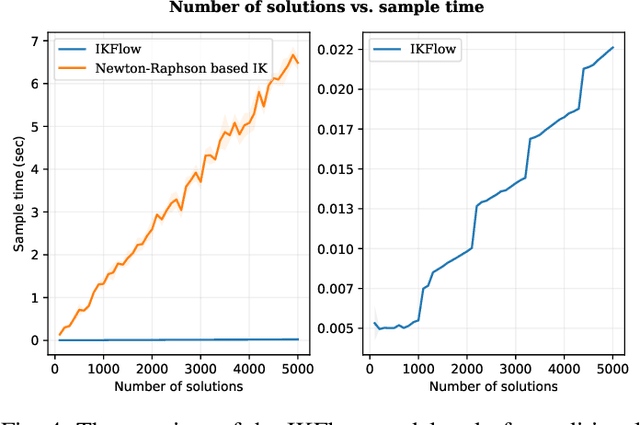
Abstract:Inverse kinematics - finding joint poses that reach a given Cartesian-space end-effector pose - is a common operation in robotics, since goals and waypoints are typically defined in Cartesian space, but robots must be controlled in joint space. However, existing inverse kinematics solvers return a single solution pose, where systems with more than 6 degrees of freedom support infinitely many such solutions, which can be useful in the presence of constraints, pose preferences, or obstacles. We introduce a method that uses a deep neural network to learn to generate a diverse set of samples from the solution space of such kinematic chains. The resulting samples can be generated quickly (2000 solutions in under 10ms) and accurately (to within 10 millimeters and 2 degrees of an exact solution) and can be rapidly refined by classical methods if necessary.
Guided Policy Search for Parameterized Skills using Adverbs
Oct 23, 2021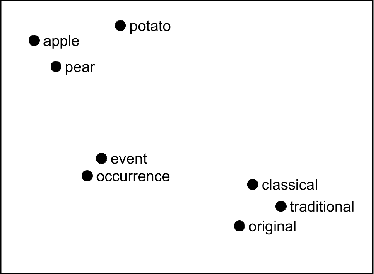
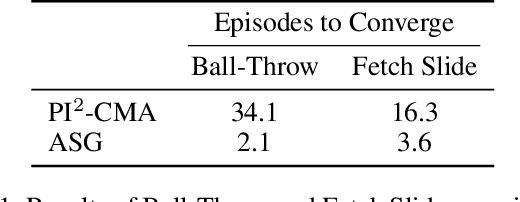


Abstract:We present a method for using adverb phrases to adjust skill parameters via learned adverb-skill groundings. These groundings allow an agent to use adverb feedback provided by a human to directly update a skill policy, in a manner similar to traditional local policy search methods. We show that our method can be used as a drop-in replacement for these policy search methods when dense reward from the environment is not available but human language feedback is. We demonstrate improved sample efficiency over modern policy search methods in two experiments.
Coarse-Grained Smoothness for RL in Metric Spaces
Oct 23, 2021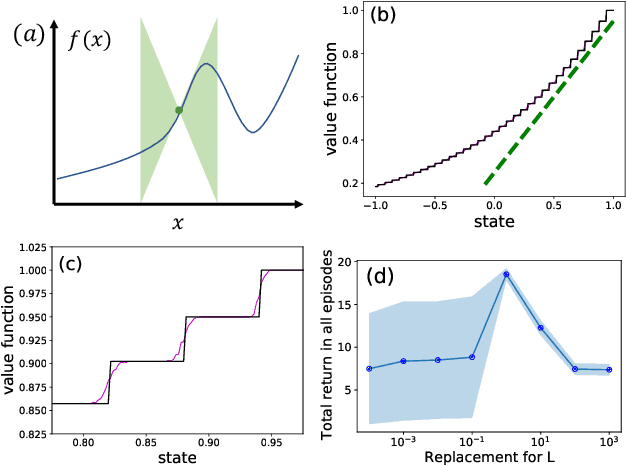
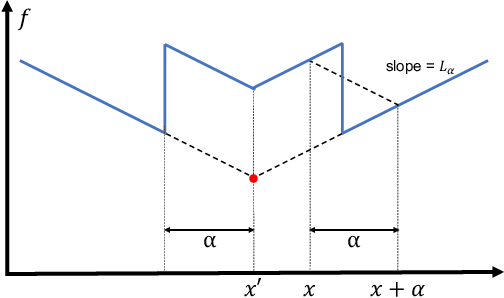
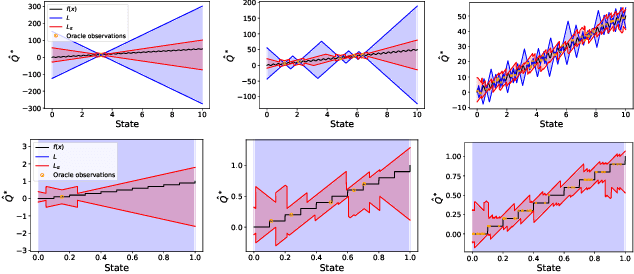
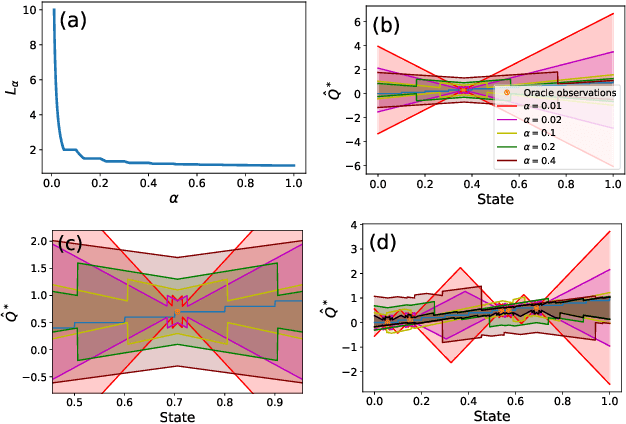
Abstract:Principled decision-making in continuous state--action spaces is impossible without some assumptions. A common approach is to assume Lipschitz continuity of the Q-function. We show that, unfortunately, this property fails to hold in many typical domains. We propose a new coarse-grained smoothness definition that generalizes the notion of Lipschitz continuity, is more widely applicable, and allows us to compute significantly tighter bounds on Q-functions, leading to improved learning. We provide a theoretical analysis of our new smoothness definition, and discuss its implications and impact on control and exploration in continuous domains.
Towards Optimal Correlational Object Search
Oct 19, 2021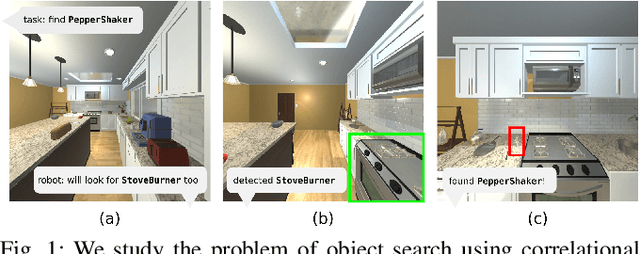
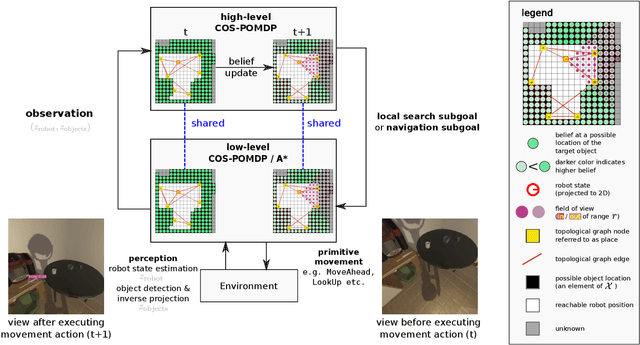
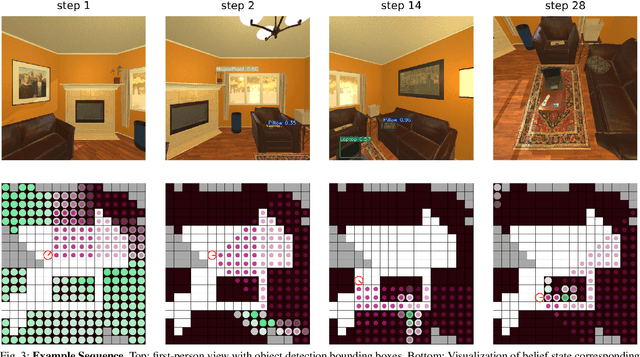
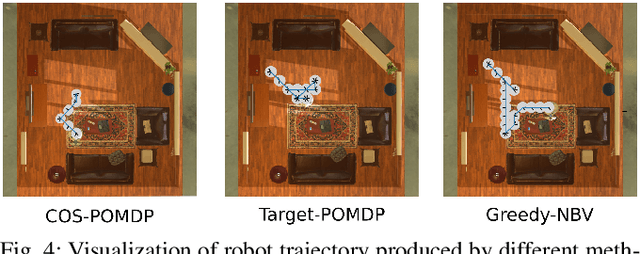
Abstract:In realistic applications of object search, robots will need to locate target objects in complex environments while coping with unreliable sensors, especially for small or hard-to-detect objects. In such settings, correlational information can be valuable for planning efficiently: when looking for a fork, the robot could start by locating the easier-to-detect refrigerator, since forks would probably be found nearby. Previous approaches to object search with correlational information typically resort to ad-hoc or greedy search strategies. In this paper, we propose the Correlational Object Search POMDP (COS-POMDP), which can be solved to produce search strategies that use correlational information. COS-POMDPs contain a correlation-based observation model that allows us to avoid the exponential blow-up of maintaining a joint belief about all objects, while preserving the optimal solution to this naive, exponential POMDP formulation. We propose a hierarchical planning algorithm to scale up COS-POMDP for practical domains. We conduct experiments using AI2-THOR, a realistic simulator of household environments, as well as YOLOv5, a widely-used object detector. Our results show that, particularly for hard-to-detect objects, such as scrub brush and remote control, our method offers the most robust performance compared to baselines that ignore correlations as well as a greedy, next-best view approach.
 Add to Chrome
Add to Chrome Add to Firefox
Add to Firefox Add to Edge
Add to Edge